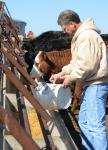COLUMBIA, Mo. – With the early spring warm-up, farmers may face two herbicide applications instead of one before they start planting soybeans.
“Normally, giant ragweed emerges around the first of April,” said Kevin Bradley, University of Missouri Extension weed specialist. “But this year they appeared in farm fields about three weeks ago, well ahead of normal.
“The problem is, giant ragweed is an indicator species,” Bradley continued. “Once this weed emerges, many others fall in line right behind it. We may have a problem.”
If warm weather continues, farmers may have to repeat their normal burn-down herbicide applications before planting time. Also, a residual herbicide normally applied with pre-emergent herbicide will have expired before soybeans are planted.
A burn-down application prepares the fields for planting. However, farmers should not plant soybeans until well after the frost-free dates across the state. Frosts can occur through the second week of April in northwestern Missouri.
“In meetings in early March, farmers were already talking about planting early,” Bradley said.
Bradley has campaigned hard in recent years to have growers combine a residual herbicide with their pre-emergent burn-down application ahead of planting. One knocks down weeds ahead of planting. The other prevents weeds from coming up after planting.
“With the strong price of soybeans this year, it seemed that farmers were prepared to do the right thing,” Bradley said. “But an early spring complicates that plan.
“To do a good job, it may take two trips across the field before planting this year,” he said.
“When I saw those emerging giant ragweed three weeks ago, I came back to look at our weed-emergence models,” Bradley said. “I knew something was off.”
MU computer models predict emergence dates for various weed species. Predictions are based on accumulated growing degree days. That didn’t work following a mild winter.
“Winter weeds are in full bloom, and summer annuals were emerging before spring arrived,” Bradley said. “We reprogrammed the weed-emergence models.”
Farmers can subscribe to a weed-emergence outlook as part of the MU Horizon Point service. Emails report weeds, insect emergence, soil temperatures, rain runoff risks, weather forecasts and other management information.
To subscribe to MU forecasts, go to agebb.missouri.edu/horizonpoint. Farmers must submit email address, location of farm by longitude and latitude, and soil type. More than one farm location can be entered. Forecasts are site-specific.
Any GPS device will provide longitude and latitude.
From visits with certified crop advisers across the state, Bradley heard reports of heavy sales of herbicides this winter. “The farmers were ready,” he said. “Now they may have to go back to buy more.
“We can hope the price of soybeans stays high,” he added. “With the price up, farmers will do all they can to get a good crop.”
In the last week of March, the July soybean futures price in Chicago was hitting near $14 per bushel.
Read more http://extension.missouri.edu/news/DisplayStory.aspx?N=1376





